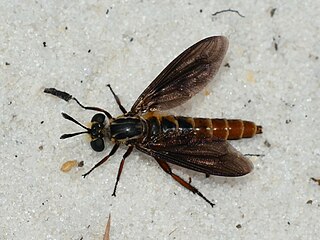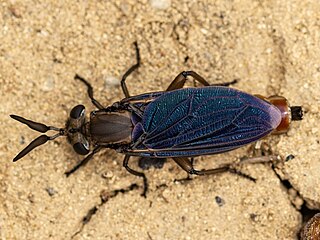
The Mydidae, or Mydas flies, are a cosmopolitan family of flies. It is a small family, with about 471 species described. They are generally large in size, including the largest known fly, Gauromydas heros. Many of the species, in addition to their large size, are mimics of stinging hymenopterans, especially wasps.

Nemomydas is a genus of flies in the family Mydidae.
Rhopalia is a genus of flies in the family Mydidae.

Leptomydinae is a subfamily of mydas flies in the family Mydidae primarily distributed in the Northern Hemisphere.

Phyllomydas is a genus of flies in the family Mydidae.

Mydas is a genus of flies in the family Mydidae.
Pseudonomoneura is a genus of flies in the family Mydidae.
Afroleptomydas is a genus of flies in the family Mydidae.

Leptomydas is a genus of flies in the family Mydidae that occurs in Europe and Asia.

Ectyphus is a genus of flies in the family Mydidae.
Apiophorinae is a subfamily of mydas flies in the family Mydidae.
Mitrodetus is a genus of flies in the family Mydidae.
Cephalocera is a genus of flies in the family Mydidae.
Syllegomydas is a genus of flies in the family Mydidae.
Arenomydas is a genus of flies in the family Mydidae.
Perissocerus is a genus of flies in the family Mydidae.
Rhopaliinae is a subfamily of mydas flies in the family Mydidae.
Anomalomydas is a genus of flies in the family Mydidae.
Neorhaphiomidas is a genus of flies in the family Mydidae.
Diochlistus is a genus of flies in the family Mydidae.






